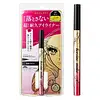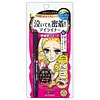What's inside
What's inside
 Key Ingredients
Key Ingredients

 Benefits
Benefits

 Concerns
Concerns

 Ingredients Side-by-side
Ingredients Side-by-side

Water
Skin ConditioningCI 77266
Cosmetic ColorantButylene Glycol
HumectantStyrene/Acrylates/Ammonium Methacrylate Copolymer
Styrene/Acrylates Copolymer
Acrylates Copolymer
1,2-Hexanediol
Skin ConditioningPentylene Glycol
Skin ConditioningPhenoxyethanol
PreservativeCaprylyl Glycol
EmollientSodium Hydroxide
BufferingSodium Laureth-12 Sulfate
CleansingEthylhexylglycerin
Skin ConditioningSodium Dehydroacetate
PreservativeC11-15 Pareth-7
EmulsifyingPotassium Sorbate
PreservativeTetrasodium EDTA
Beheneth-30
CleansingPanthenol
Skin ConditioningAlcohol
AntimicrobialAcrylates/Ethylhexyl Acrylate Copolymer
Methylparaben
PreservativeAcrylates/Dimethylaminoethyl Methacrylate Copolymer
Polyquaternium-51
Skin ConditioningPropylparaben
PreservativeSwertia Japonica Extract
Skin ConditioningRosa Canina Fruit Extract
AstringentSodium Hyaluronate
HumectantDisodium Phosphate
BufferingPotassium Phosphate
BufferingSuccinoyl Atelocollagen
Skin ConditioningWater, CI 77266, Butylene Glycol, Styrene/Acrylates/Ammonium Methacrylate Copolymer, Styrene/Acrylates Copolymer, Acrylates Copolymer, 1,2-Hexanediol, Pentylene Glycol, Phenoxyethanol, Caprylyl Glycol, Sodium Hydroxide, Sodium Laureth-12 Sulfate, Ethylhexylglycerin, Sodium Dehydroacetate, C11-15 Pareth-7, Potassium Sorbate, Tetrasodium EDTA, Beheneth-30, Panthenol, Alcohol, Acrylates/Ethylhexyl Acrylate Copolymer, Methylparaben, Acrylates/Dimethylaminoethyl Methacrylate Copolymer, Polyquaternium-51, Propylparaben, Swertia Japonica Extract, Rosa Canina Fruit Extract, Sodium Hyaluronate, Disodium Phosphate, Potassium Phosphate, Succinoyl Atelocollagen
Water
Skin ConditioningEthylhexyl Acrylate/Methyl Methacrylate Copolymer
CI 77266
Cosmetic ColorantButylene Glycol
HumectantStyrene/Acrylates Copolymer
Alcohol
AntimicrobialCeramide AP
Skin Conditioning1,2-Hexanediol
Skin ConditioningAmmonium Acrylates/Methylstyrene/Styrene Copolymer
Acrylates/Octylacrylamide Copolymer
Phenoxyethanol
PreservativeBeheneth-30
CleansingMethylparaben
PreservativeTriethanolamine
BufferingAminomethyl Propanol
BufferingPropylparaben
PreservativeDisodium EDTA
Sodium Dehydroacetate
PreservativeSodium Benzoate
MaskingPanthenol
Skin ConditioningRosa Canina Fruit Extract
AstringentSodium Hyaluronate
HumectantSuccinoyl Atelocollagen
Skin ConditioningWater, Ethylhexyl Acrylate/Methyl Methacrylate Copolymer, CI 77266, Butylene Glycol, Styrene/Acrylates Copolymer, Alcohol, Ceramide AP, 1,2-Hexanediol, Ammonium Acrylates/Methylstyrene/Styrene Copolymer, Acrylates/Octylacrylamide Copolymer, Phenoxyethanol, Beheneth-30, Methylparaben, Triethanolamine, Aminomethyl Propanol, Propylparaben, Disodium EDTA, Sodium Dehydroacetate, Sodium Benzoate, Panthenol, Rosa Canina Fruit Extract, Sodium Hyaluronate, Succinoyl Atelocollagen
 Reviews
Reviews

Ingredients Explained
These ingredients are found in both products.
Ingredients higher up in an ingredient list are typically present in a larger amount.
1,2-Hexanediol is a synthetic liquid and another multi-functional powerhouse.
It is a:
- Humectant, drawing moisture into the skin
- Emollient, helping to soften skin
- Solvent, dispersing and stabilizing formulas
- Preservative booster, enhancing the antimicrobial activity of other preservatives
Alcohol comes in many different forms. Different types of alcohol will have different effects on skin. This ingredient is usually an astringent alcohol.
These alcohols are drying on the skin. They may strip away your skin's natural oils and even damage your skin barrier. Astringent alcohols may also irritate skin.
Other types of astringent alcohols include:
According to the National Rosacea Society based in the US, you should be mindful of products with these alcohols in the top half of ingredients.
Any type of sanitizing product will have high amounts of alcohol to help kill bacteria and viruses.
Fatty alcohols come from plant oils such as coconut oil. These can help hydrate the skin and are non-irritating. Some fatty alcohols include cetyl and stearyl alcohol.
Learn more about AlcoholWe don't have a description for Beheneth-30 yet.
Butylene Glycol (or BG) is used within cosmetic products for a few different reasons:
Overall, Butylene Glycol is a safe and well-rounded ingredient that works well with other ingredients.
Though this ingredient works well with most skin types, some people with sensitive skin may experience a reaction such as allergic rashes, closed comedones, or itchiness.
Learn more about Butylene GlycolMethylparaben is a preservative and is a paraben. It is used to prevent the growth of fungus, mold, and other harmful bacteria. Parabens are chemicals used as preservatives in both cosmetics and food.
Methylparaben can be synthetically created. It can also be found naturally in some fruits, such as blueberries.
Oftentimes, Methylparaben is combined with other parabens to help increase the shelf life.
The safety of Methylparaben is currently being studied. While ongoing studies are looking into the safety of parabens, the results have been very mixed. Some studies have not found Methylparaben to be harmful.
Learn more about MethylparabenPanthenol is a common ingredient that helps hydrate and soothe the skin. It is found naturally in our skin and hair.
There are two forms of panthenol: D and L.
D-panthenol is also known as dexpanthenol. Most cosmetics use dexpanthenol or a mixture of D and L-panthenol.
Panthenol is famous due to its ability to go deeper into the skin's layers. Using this ingredient has numerous pros (and no cons):
Like hyaluronic acid, panthenol is a humectant. Humectants are able to bind and hold large amounts of water to keep skin hydrated.
This ingredient works well for wound healing. It works by increasing tissue in the wound and helps close open wounds.
Once oxidized, panthenol converts to pantothenic acid. Panthothenic acid is found in all living cells.
This ingredient is also referred to as pro-vitamin B5.
Learn more about PanthenolPhenoxyethanol is a preservative that has germicide, antimicrobial, and aromatic properties. Studies show that phenoxyethanol can prevent microbial growth. By itself, it has a scent that is similar to that of a rose.
It's often used in formulations along with Caprylyl Glycol to preserve the shelf life of products.
Propylparaben is a preservative and is a paraben with antifungal and antimicrobial properties.
This ingredient can be naturally found in plants and insects, but most of it is synthetically manufactured for human use. In cosmetics, it is usually created by reacting para-aminobenzoic acid and propanol (an alcohol).
You can usually find this ingredient in water-based products.
Parabens have come under controversy due to the claim they are hormone disruptors. Studies show conflicting results. We recommend speaking with a professional if you have any concerns.
Propylparaben is commonly found in food, medicine, and cosmetics.
Learn more about PropylparabenRosa Canina Fruit Extract is from Rosehip. Rosehips are a fruit from a wild rose bush native to Eurasia and Africa.
Rosehip contains Vitamin C, Vitamin E, fatty acids and linolenic acids that hydrate skin. Having hydrated skin helps reduce the appearance of fine-lines and wrinkles.
Vitamins C and E are potent antioxidants and may help with anti-aging. The fatty acids are emollients that help soften and hydrate your skin.
Another potent vitamin found in rosehip is Vitamin A, or retinol. Retinol encourages collagen production in the skin.
Rosehip extract may help with brightening the skin. Several components, such as beta-carotene, are able to reduce pigmentation caused by sun damage.
Learn more about Rosa Canina Fruit ExtractThis ingredient is a preservative with antimicrobial properties. It is the sodium salt of dehydroacetic acid.
It is especially effective at preventing bacterial and fungal growth in low concentrations.
Sodium Hyaluronate is hyaluronic acid's salt form. It is commonly derived from the sodium salt of hyaluronic acid.
Like hyaluronic acid, it is great at holding water and acts as a humectant. This makes it a great skin hydrating ingredient.
Sodium Hyaluronate is naturally occurring in our bodies and is mostly found in eye fluid and joints.
These are some other common types of Hyaluronic Acid:
Learn more about Sodium HyaluronateWe don't have a description for Styrene/Acrylates Copolymer yet.
Succinoyl Atelocollagen can help to reduce the effects of aging.
Water. It's the most common cosmetic ingredient of all. You'll usually see it at the top of ingredient lists, meaning that it makes up the largest part of the product.
So why is it so popular? Water most often acts as a solvent - this means that it helps dissolve other ingredients into the formulation.
You'll also recognize water as that liquid we all need to stay alive. If you see this, drink a glass of water. Stay hydrated!
Learn more about WaterCI 77266 is a high-purity pigment used to create an intense black color in cosmetics. It is made up of fine particles of pure carbon. This ingredient is also often listed as Carbon Black in ingredient lists.
You'll likely find this ingredient in mascaras, eyeliners, brow products, and eye shadow.
In the US, this ingredient can only be used if it meets strict FDA specifications. Certain versions even require batch-by-batch certification after extensive safety evaluation.
In the European Union, this ingredient is permitted as a colorant and classified as a "nanomaterial" based on its particle size (meaning it requires deeper assessment).
The EU Scientific Committee on Consumer Safety (SCCS) has reviewed nano-sized carbon black specifically and concluded that it does not pose a risk to human health when used in cosmetic products applied to healthy, intact skin and formulated to avoid inhalation.
Studies support this regulatory stance. Laboratory studies on nano-carbon black show potential for cytotoxicity and inflammatory effects in immune cells; it is important to highlight these findings are based on in vitro (not done on a living organism) testing or inhalation scenarios rather than normal topical cosmetic use.
Occupational studies involving industrial workers exposed to airborne carbon black have not shown a clear link between cumulative exposure and cancer risk. These findings are not directly applicable to cosmetics; cosmetic formulations bind pigments within creams, gels, and liquids that are not inhaled.
Overall, evidence shows that this ingredient is safe under regulatory guidelines and purity standards, especially when formulated to avoid airborne exposure.
Even with regulatory approval and a long history of use, some consumers might prefer to avoid ingredients that are petroleum-derived or that fall under the “nanomaterial” category.
Choosing whether to use CI 77266 isn’t necessarily about safety alone; it can also be about personal philosophy, comfort level with synthetic versus natural ingredients, and how much weight you place on ongoing research and regulatory oversight.
Makeup is highly individual, and personal preference plays an important role in deciding what feels right for you.
Learn more about CI 77266